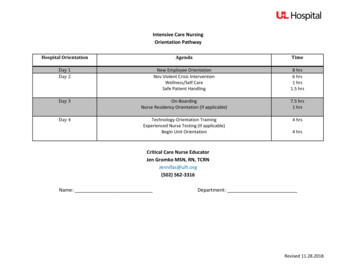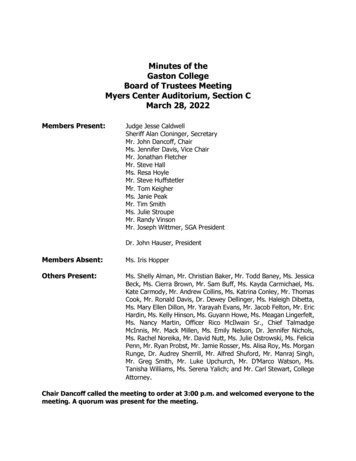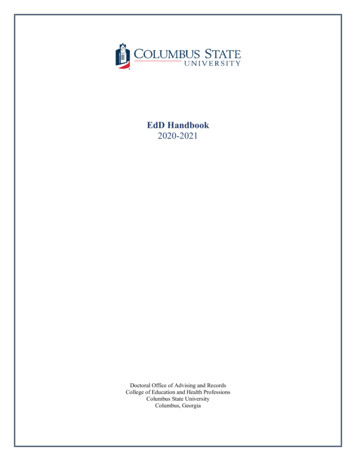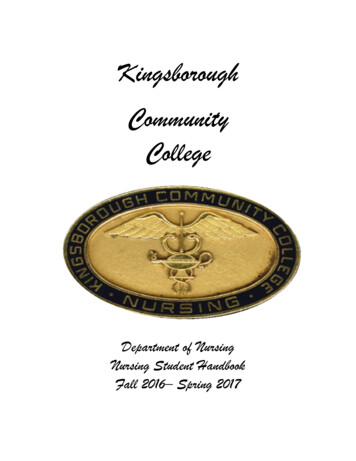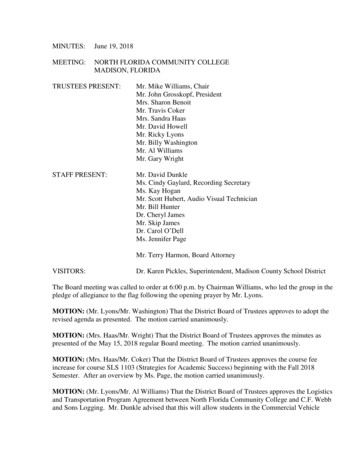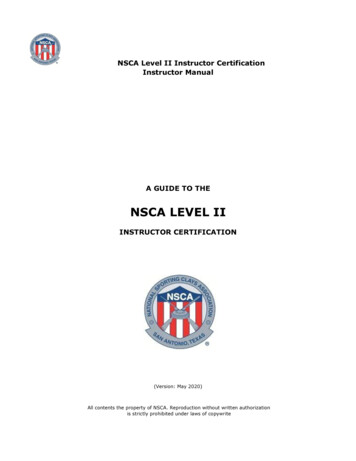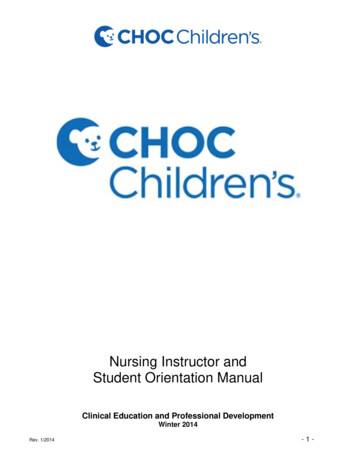
Transcription
Nursing Instructor andStudent Orientation ManualClinical Education and Professional DevelopmentWinter 2014Rev. 1/2014-1-
TABLE OF CONTENTS1.Welcome to Children’s Hospital of Orange County32.About CHOC Children’s3-43.Student Policies and Resources5-64.Unlawful Harassment65.JCAHO National Patient Safety Goals76.Safety Management87.Fire Prevention Management98.Emergency Codes109.Security Management11-1210.Emergency Management1211.Medical Equipment Management1212.Hazard Materials and Waste Management(Care of Patients Receiving Radioactive Materials)12-1313.Infection Control14-1514.Cultural Sensitivity1515.Patient Rights and Responsibilities1616.HIPAA – Confidentiality1617.Ethical Behavior17Rev. 1/2014-2-
Welcome to Children’s Hospital of Orange County (CHOC)! We are pleased that you havechosen our facility to further your education related to the care of children.CHOC Children's and CHOC Children's at Mission Hospital form the backbone of OrangeCounty's premier resource for pediatric health care. The two not-for-profit hospitals are OrangeCounty's only hospitals exclusively serving infants, children and adolescents.Since opening our doors in 1964, Children’s Hospital of Orange County (CHOC) has providedthe highest quality medical care to children. Our regional health system includes a state-of-theart main hospital facility in the City of Orange, a hospital-within-a hospital in Mission Viejo, andfive community clinics — plus over 100 additional programs and services. With admissionsgrowing by 90% over the last eight years, CHOC and CHOC at Mission combined rank as the15th busiest children’s hospital in the country.At CHOC “We aspire to partner with children and families to deliver what matters to them”CHOC’S MISSION STATEMENT(Why we exist)The CHOC mission is, “to nurture, advance and protect the health and well-being of children.”Within the boundaries of financial responsibility and quality performance, the highest level ofcare is provided to children from all socioeconomic levels without regard to race, creed, nationalorigin, religious preference or the family’s ability to pay.CHOC’S VISIONTo be the leading destination for children’s health by providing exceptional and innovative care.CHOC’S VALUES vice:AccountabilityRev. 1/2014Setting and achieving the highest standardsCaring with sensitivity and respectAdvancing care through new ideas and technologyWorking together to achieve our MissionUnderstanding and exceeding customer expectationsServing as dedicated stewards of the lives and resources entrustedto us-3-
Rev. 1/2014-4-
Building the future for our children CHOC Children’s South TowerOpened April 2013 Tower Completed April 2013 Over 400 new associates on-boardedRev. 1/2014-5-
STUDENT POLICIES AND RESOURCESCHOC Student ID Badge:The Security Department will issue a student ID badge on your first day at CHOC. Thesebadges will serve as your ID and will also allow you to access the parking lots, hospital, & otherauthorized areas.You must wear your yellow CHOC student ID badge and your school badge at all timeswhile you are on the CHOC campus. Do not place any stickers (except Flu Stickers) onyour badge or puncture your badge with pins as this will affect the magnetic strip onyour badge.Parking:Obtain your parking permit from your instructor. This permit must be displayed on yourdashboard at all times while on the CHOC campus. Please park in the CHOC Employee Parking Structure, floors 7-9. You will need yourCHOC student badge to access the employee parking structure.Computer Documentation (CUBS) Training:All students providing patient care are required to complete the CUBS Web Based Training andattend an orientation with their instructor.Dress Code:Nursing students providing patient care must wear their school uniform. All students mustfollow the dress code policy. (see separate policy).Artificial Nails: are not allowed for direct, hands-on patient care providers. Natural nails areclean and not longer than ¼ inch from the finger tip.Restraints:Students and Instructors are not allowed to take off or place restraints on patients. This must becompleted by a CHOC Associate. However students should be aware of the following:Chemical Restraints and Seclusion are not used at CHOC.No-No’s are considered a restraint at CHOC.Unlawful Harrassment:CHOC is committed to providing a work environment that is free of discrimination orharassment. In keeping with this commitment, the Hospital maintains a strict policy prohibitingverbal, physical and visual harassment and harassment of any type by an Associate, agent ofthe Hospital or other person because of sex, race, color, national origin, ancestry, religiouscreed, physical or mental disability, medical condition, marital status, sexual orientation, age orany other basis protected by federal, state or local law, ordinance or regulation.If you see or are subjected to harassment:All Hospital Associates, Volunteers, and Students who are aware of apparent sexualharassment to themselves or to others, are required to immediately report that harassment tohis or her supervisor or Human ResourcesRev. 1/2014-6-
Rev. 1/2014-7-
SAFETY MANAGEMENT IN THE ENVIRONMENT OF CARESafety Officer: Barbara PrinceCHOC’s Safety Policies are found in the Environment of Care (EOC) Manual on each unit.The EOC Manual refers to safety in seven areas Safety ManagementMedical Equipment ManagementFire PreventionUtility Systems Management Security Management Hazardous Materials and Waste Emergency ManagementResponsibilities for Maintaining a Safe Work Environment Be well rested before coming to workRead Student Orientation ManualFollow Hospital & Department P&P’sKnow how to respond in an emergencyReport a safety hazard promptly Report violence in the workplace &missing property to security immediately. Wear CHOC Student ID badge & schoolID badge above the waist.Reporting a Safety HazardContact SupervisorVisitor Injury Notify immediate Supervisor Contact SecurityMedications & Needle Safety Medications and needles must be secured and lockedUse safety engineered sharps when availableReport medication errors and near misses on a Notification FormReport sharps injuries on an Illness & Injury Report FormWork Related Injuries Report all injuries immediately to your Instructor, Charge Nurse, Nursing Supervisor, StudentRelations Coordinator, and Workman’s Compensation through your college or university. Within 24 hours report injury to Associate Health & complete the Illness & Injury Report Form. Immediate medical care available by referral (first-aid – Associate Health, serious injuries – St.Joseph’s Emergency Department) Any piece of furniture or equipment involved in an injury must be tagged, sequestered andsent to Plant OperationRev. 1/2014-8-
FIRE PREVENTION MANAGEMENTEnvironment of Care Manual (EOC) – Fire Prevention PlanFollow the RACE procedure in the event of a fire:RRESCUE patients or other people in immediate dangerAALERT others by pulling the nearest fire alarm or dialing “66”CCONFINE the fire by closing all doors and windowsEEXTINGUISH the fire by using the correct extinguisherResponsibilities of Associates, Volunteers, and Students when fire alarm is activated: Close all doors in your area. Go to your assigned work area and stay there. Make sure all the patients are present and tell them to stay in their room. Tell visitors that do not want to stay with the patients to stay in the waiting areas until the“ALL CLEAR” signal has been given. Remove everything from the hallways (beds, wagons, highchairs) & close all doors. Remain Calm. DO NOT call the operator unless you need emergency help.Fire Safety Preparation Know where fire alarm pull stations and fire extinguishers are located. Familiarize yourself with your department’s Evacuation Plan. Know where safety exits and relocation points are for your department. Know how to evacuate yourself and patients as advised by the Fire Department,Plant Operations or SecurityUSING A FIRE EXTINGUISHERPPull the pinAAim at base of fireSSqueeze leverSSweep from side to sideRev. 1/2014-9-
CHOC Emergency CodesDIAL “66”CodeWhat it MeansWhat to DoCode RedFire, Smoke, GasCode YellowBomb ThreatCode GreyAssaultive BehaviorCode SilverPerson threatening withweapon; hostage takenCode PinkInfant Abduction: Child oneyearCode PurpleChild Abduction:Child one yearCode WhiteMedical emergency pediatric;cardiac/respiratory arrestMedical emergency adult;cardiac/respiratory arrestHazardous Materials spill,release or exposureR.A.C.E.Rescue.Alert.Confine.ExtinguishDo not use radio – call 33-8050Do not page Code YellowDo not handle the item in questionOff-site call 911Activate a Code Grey by dialing “66”Off-site call 911Dial “66”Secure doors, seek coverTurn radio to “3” or “C”Off-site call 911Monitor exitsTurn radio to “A” or “1”Search immediate areaMonitor exitsTurn radio to “A” or “1”Search immediate areaDo not use elevators until all clearInitiate CPR, if trainedDo not use elevators until all clearInitiate CPR if trainedSecure areaIf trained, clean-upIf untrained, call “66”Code team responds to evaluate patientCode Blue – AdultCode OrangeRapid ResponseCode TriageStandbyCode TriageInternalCode TriageExternalRev. 1/2014Med/Surg & Oncology patientevaluationConfidential communicationalertInternal Disaster (i.e. pipeburst)External Disaster (i.e. masscasualty car accident)Radio on channel “C” or “3”Activates the Disaster PlanActivates the Disaster Plan- 10 -
SECURITY MANAGEMENTSecurity Office: 13900 - Dial “66” to call a code(911 for off-site facilities) To report a security incident or crime call 13900. State name, location, facility and department State nature of incident or crime Inform security of any threat of danger responding officer can expect Report any suspicious activity to security. Keep valuables in a locked or secure area.Visitor/Patient/Family Security Make sure patients have armbands on at all times. Notify your supervisor if you observe anyone who does not have a CHOC ID badge, yellowparent armband or visitor badge. Wear your ID badge at all times above the waist so it is visible.Workplace ViolenceThe policy regarding workplace violence establishes an expectation that the hospital will providea safe working environment and prohibits the actual or threat of violence by Associates,Volunteers, and Students against co-workers or other persons.For information on how and when to access the team, please refer to the hospital Policy on SafeWorkplace Violence Prevention. Preventative Measures: Treat everyone with respectRemember people with sick children are under stress Potentially violent behaviors include but are not limited to: Destruction of propertyReal or implied verbal threatsMenacing gesturesUse of abusive languageDisplay of intense or obsessive romantic interestHarassing or intimidating others Actions to Take: Report any incidents to your immediate Supervisor or House SupervisorPossession of WeaponsNo firearms or dangerous weapons (knives, etc.), including pepper spray, mace or teargas will beallowed on the hospital campus.Rev. 1/2014- 11 -
EMERGENCY MANAGEMENT PLANHospital Emergency Incident Command System (HEICS)If you are on duty: Follow your supervisors directions The overhead paging system, 2-way radio or your supervisor will tell you the type ofsituation CHOC is facing.1. Disaster within the hospital, (e.g. physical damage or utility system failure)2. Disaster in the community (e.g. fire, earthquake, plane crash, terrorism event)MEDICAL EQUIPMENT MANAGEMENTIf a malfunction is suspected please notify the immediate supervisor as soon as possible.If you have not previously used or been trained in the use of a piece of equipment please contactyour supervisor prior to using the equipment.HAZARDOUS MATERIALS AND WASTE MANAGEMENT Material Safety Data Sheet (MSDS) Information: MSDS can be obtained 24 hours a day by calling the 3E Company at 1-800-451-8346 oraccessing MSDS via PAWS MSDS tells you important information regarding the producto Physical and chemical propertieso Physical hazardso Health hazardso Safe exposure limitso Precautions for safe handling, use and controlo Emergency and first aid procedureso Waste disposal procedures Code Orange – Hazardous Materials Incident, Spill or Release A Code Orange should be paged when a known or unknown hazardous substance spill,release or threatened release either exceeds the limits of safe cleanup, containment, orAssociate training and is evaluated to be uncontrollable, flammable, highly toxic and/orreactive.DO’SFollow directions for proper chemical useWear proper protective clothing for the taskDon’tsLeave chemical containers open or unlabeledMix chemicals – not even with water unlessdirectedUse protective equipment correctly (i.e.: eye shields)Know the MSDS on chemicals in your work areaKnow how to operate eye wash stationRev. 1/2014- 12 -
Waste Disposal Red Bags are used for Biohazard or infectious wasteYellow Bags are used for chemotherapy wasteBlue Bags are used for linenClear Bags are for regular waste White and Blue Containers are used for pharmaceutical waste Pharmaceuticals are not to be placed into a sharps container with needles. Radioactive WasteRev. 1/2014- Patients who return from a Nuclear Medicine Imaging Study (i.e., Bone Scans,Renal Scans, Gallium, GI Bleed Scans) shall be identified by a set ofyellow/magenta labels which state: “Caution – Injected with radioisotope ” and/or“Patient injected with radionuclide ” placed on their chart by the Nuclear MedicineDepartment. These labels will identify the patient, date of injection, and timeperiod for which this isolation procedure will remain in effect. The labels will beplaced on the patient’s sharps container, diaper waste bag, lab work and suctionscanister. All patients whose charts contain these labels are considered potential sources ofbody fluid radioactive contaminated waste upon return to the nursing unit. The sharps container and the covered diaper container will be labeled with theyellow/magenta sticker until the time period for this isolation of medical waste haselapsed. If the patient uses the toilet, bedpan, or urinal no special precautions arerequired. Clear plastic bags are to be used in the diaper pail. The disposalcontainer with clear plastic bag, and stickers should only be used for contaminatedpatient waste materials only.- 13
INFECTION CONTROLRefer to the Infection Control Manual, Section: Isolation PrecautionsRationale for Isolation Precautions in Hospital (200) & Standard Precautions (203)Hand Hygiene is the single most effective way to prevent the spread of infectionAlcohol Gel (hand sanitizer): used when hands are not visibly soiled; before/after patient orenvironmental contact (touching equipment/furniture); and after removing gloves.Traditional Hand Washing: used when hands are visibly soiled with blood, urine, feces,vomit, formula, sputum, food, etc.; before eating; after using the restroom; and with patientswho have Clostridium difficile. When washing, please rub hands together vigorously withsoap and water for 15 seconds.Gloves : Wear gloves (clean, nonsterile gloves) when touching blood, body fluids,secretions, excretions and contaminated items. Sterile gloves should be utilized whileperforming sterile procedures. Wearing gloves does not replace the need for hand hygieneMask, Eye Protection, Face Shield : Wear a mask and eye protection or a face shield toprotect mucous membranes of the eyes, nose and mouth during procedures and patient-careactivities that are likely to generate splashes or sprays of blood, body fluids, secretions, andexcretions.Gown : Wear a gown (a clean, nonsterile gown) to protect skin and to prevent soiling ofclothing during procedures and patient-care activities that may involve splashes or sprays ofbody Fluids.Transport of Infected Patients For Transport of patients in isolation please check with the patient’s nurse.Occupational Health and Bloodborne Pathogen Standard precautions are the use of barriers or personal protective equipment (PPE gloves, gowns, masks, goggles/face shields, portable resuscitation devices.) toprotect you from contact with body fluids while you are doing your job. Tuberculosis (TB) – Students should not care for TB patients unless they havebeen TB mask fitted at CHOC. Take care to prevent injuries when using needles, scalpels and other sharpinstruments or devises; handling sharp instruments after procedures; cleaning usedinstruments; and/or disposing of used needles. Never recap used needles, or otherwise manipulate them. Place used disposable syringes and needles, scalpel blades, and other sharp itemsin appropriate puncture-resistant containers. Eating, drinking, applying cosmetics or lip balm and handling contact lenses areprohibited in nurses’ stations and work areas where there is reasonable likelihood ofoccupational exposure to pathogens. These practices must be limited to designatedareas (staff lounge, cafeteria, conference rooms, etc).Rev. 1/2014-- 14
If personal clothing becomes contaminated with blood or body fluids, which requirethe clothing to be changed, the clothing should be placed in a plastic bag and takenhome. Temporary scrubs will be issued to the student. Blood spills should be cleaned up promptly with a 1:10 solution of bleach. (SeeInfection Control Policy, Management of Blood Spills). Broken glass, which may be contaminated, shall not be picked up directly with thehands. It shall be cleaned up using a brush and dustpan, tongs or forceps. Suchequipment may be found in the Blood Spill Kit. It should be disposed of into the largered sharps containers, which are puncture resistant & leak proof. Health care workers with exudative or weeping dermatitis should refrain from alldirect patient care and from handling patient care equipment until the conditionresolves. Surgical caps or hoods and/or shoe covers shall be worn when gross contaminationcan reasonably be anticipated (e.g., orthopedic surgery).CULTURALLY COMPETENTWe at CHOC Children’s recognize the diversity and uniqueness of our workplace. Theexpectation is for all to create an environment that is respectful of differences and encourageindividuals to learn about other cultures from each other. Professional Interventions thatpromote cultural sensitivity and competency include: Be warm and personalBe helpful as soon as possibleBuild trust and empowermentDemonstrate respectRev. 1/2014-- 15
PATIENT RIGHTS AND RESPONSIBILITIES (posted in patient rooms)CHOC Children’s goal is to provide each patient/family with outstanding healthcare andexemplary customer service.Each patient/family receives information regarding their rights and responsibilities and weendeavor to protect those rights at all times. We encourage family-centered care andpatient and family involvement in decisions regarding their medical care.HIPAAPlease review the information on the Confidentiality Statement prior to signing and turning in.Everyone at CHOC is responsible for complying with HIPAA, and monitoring compliance.How can I comply with the regulations?Always dispose of any and all patient identifiable information into a shred bin. Never throw it in aregular trash can. Patient identifiable information can include the patient name, medical recordnumber, social security number, address, phone number, diagnosis, etc.Be sure if someone is requesting to review the patient chart that they are authorized to do so. Ifyou are not involved in the patient’s care you do not have the right to view the patient’s chart.When in doubt ask the question or refer it to your supervisor or the privacy official.HIPAA Security:All CHOC policies and procedures concerning HIPAA Security, Privacy and HIPAA Sanctionsare located on the CHOC PAWS & POI Intranet websites. CHOC supports audit controls foraccess to all of its information systems for the purposes of information security review.Workstation UseThe Citrix and Cerner environment is set to automatically log users off after a certain period ofinactivity but it is your responsibility to log off from workstations you may access once you havecompleted your work.CHOC’s mandatory password rules are as follow: Ensure that your password is complex. Never share passwords with anyone, including family members, vendors, businessassociates and CHOC associates. Your password is yours and your responsibility to protect.If an account or password is suspected to have been compromised,report the incident to CHOC ISD so your password can bechanged.Rev. 1/2014-- 16
Ethical behaviorCHOC Children’s is dedicated to achieving the highest standards of excellence in all we do. Aswe continue on our Journey to Excellence, we are committed to fostering an atmosphere thatpromotes integrity, honesty, accountability and mutual respect in all our activities.We value open, honest communication and ethical decision making. An effective, opencommunication process is key to ensuring compliance with Federal and State laws, rules andregulations as well as maintaining the exceptional quality of the services we provide.Individuals are expected to conduct themselves in a professional manner and treat everyonewith courtesy, dignity, and respect at all times. If you become aware of any situation that isinconsistent with our Standards of Conduct or iCARE principles that may place CHOCChildren’s reputation at risk, it is your responsibility to report your concern. In addition toreporting concerns to your supervisor, you always have the option to report your concerns to theCorporate Compliance Department, or through the Compliance Hotline. Toll-free anonymous reporting: (877) 388-8588 Email: ComplianceHotline@choc.orgQ: How do I know if I am conducting myself ethically?A: If you are worried about whether your actions will be discovered, if you feel a sense ofuneasiness about what you are doing, or if you are rationalizing your activities (such as thebelief that “everyone does it”), you are probably on ethical “thin ice.” Stop, step back, considerwhat you are doing, get advice, and modify your conduct accordingly.Rev. 1/2014-- 17
Nursing Instructor and Student Orientation Manual . Clinical Education and Professional Development Winter 2014 . Rev. 1/2014 - 2 - TABLE OF CONTENTS . . You must wear your yellow CHOC student ID badge and your school badge at all times while you are on the CHOC campus. Do not place any stickers (except Flu Stickers) on
